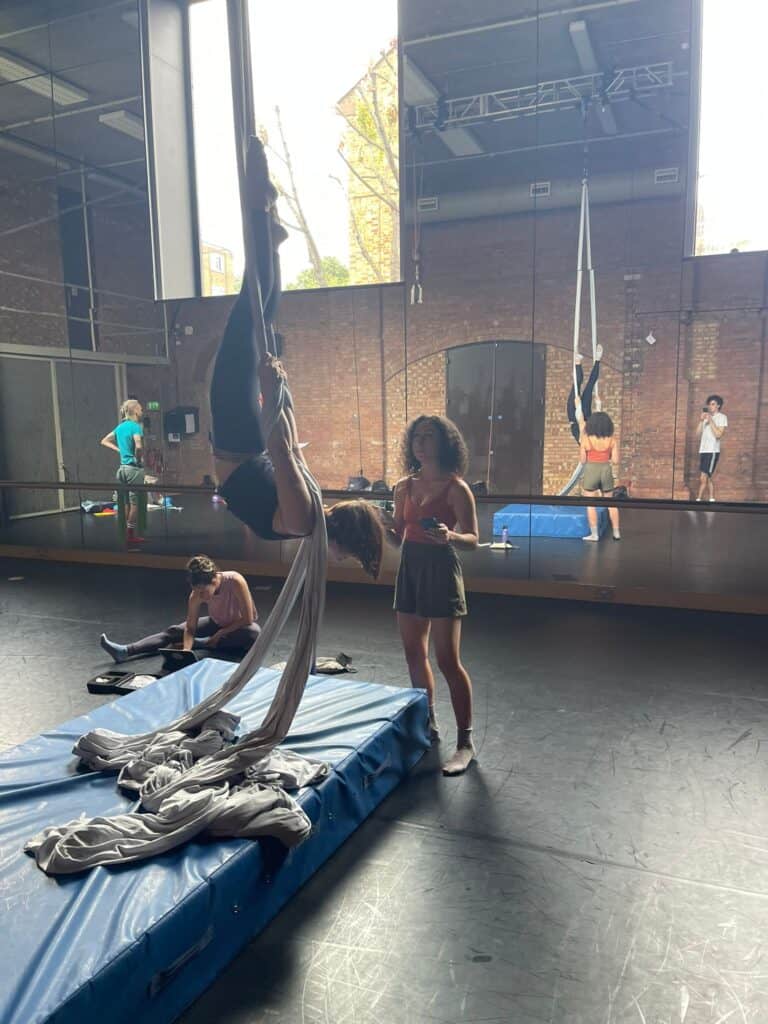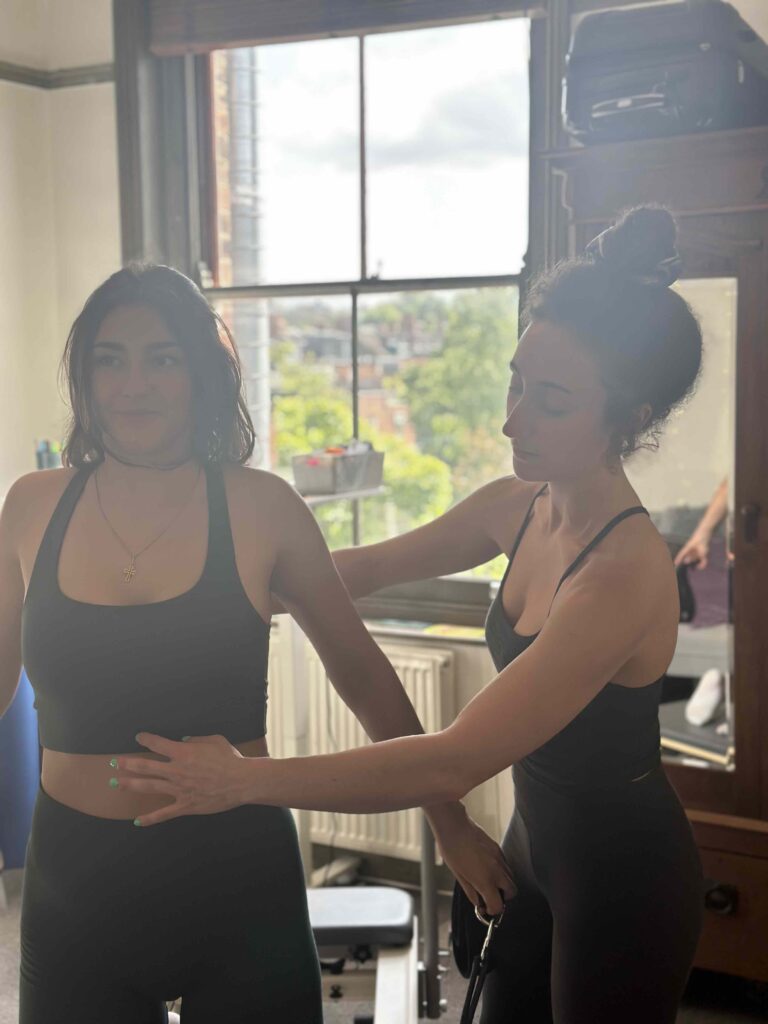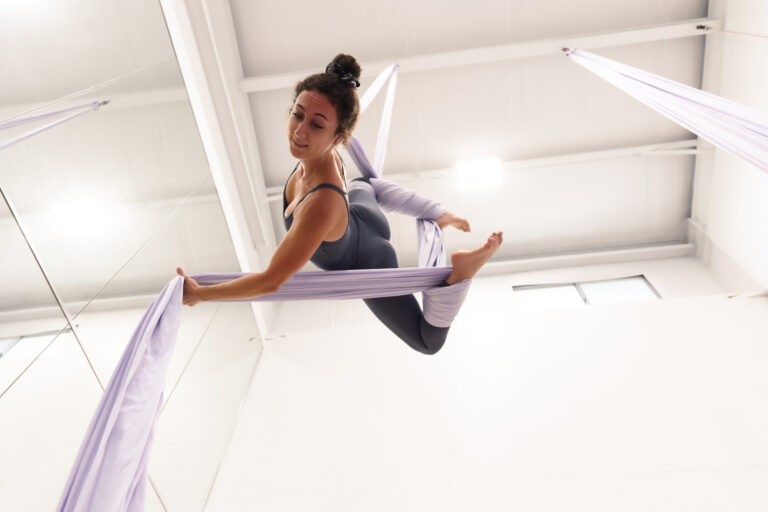Pilates for Pelvic Floor Health
It is to my delight that talking about your pelvic floor health is becoming more popular in really any setting. Even though we can’t physically see our pelvic floors, it holds so much importance from functional strength, to urinary and fecal health, sexual health and more! Having a deeper and more connected understanding on the health of your pelvic floor is key knowledge to help you have an elevated experience in all of the categories I mentioned before.
Thankfully, we can rely on the stability, mobility, and strength foundations of Pilates to unlock our most healthy pelvic floor. I wrote this blog in response to my experience working with a large range of women with different challenges in this area of life. This information is informed by my training and education from my Pilates for Women’s Health Certificate with APPI.
Blog Guide
- How does Pilates help with pelvic floor health?
- Is Pilates good for a weak bladder? What exercises make you pee less?
- Can Pilates help with a prolapsed uterus?
- How do I know I’m exercising my pelvic floor?
- Is plank good for the pelvic floor?
- Conclusion: Pilates for Pelvic Floor Health
How does Pilates help with pelvic floor health?
I like to point to Pilates as the OG for all things pelvic floor health because the foundations of Pilates are rooted in optimally softening, as well as recruiting your inner core unit. Your inner core unit includes your pelvic floor, but also includes your deepest abdominal layer (transverses abdominus), your deep spinal stabilizers (multifidi), and your diaphragm. I go through the inner core unit in some more detail as it is relevant to low back pain in my blog Pilates Body Hack: Pilates for Low Back Pain.
The Pilates foundations of breathing optimally are excellent for improving pelvic floor health. But my friends, it’s not all about the “kegel.” Optimizing pelvic floor health through breath goes further than that! While the inhale is designed to soften your pelvic floor, and allow pressure to drop down, your exhale is designed to lift up (this is where the kegel comes in). The inhale and the softening are JUST as important as the exhale.
Why? Because when all we do is think about tightening our pelvic floor during breathing exercises, we completely neglect the essential release of that muscle. Muscles need to be released, and they need to be responsive to breath. An overly tight muscle is a dysfunctional muscle, so please let the controversy of aiming to have a “tight” pelvic floor, leave you now and forever!
Outside of optimizing your breath for pelvic floor function, Pilates can help you as a form of exercise for your pelvic floor because it narrows in on lumbo-pelvic (low back to pelvic) control. To have a healthy pelvic floor, we need to zoom out of the immediate relationship of your pelvic floor to your deep abdominals and have a look at the supporting structures of the pelvis, such as your inner thighs, outer hips, your larger glutes, your hamstrings, and how all of these structures talk to one another. More on this in my blog, Pilates Body Hack: Pilates for Happy Hips.
The thing is, everyone is different. Balance in my body will probably look a lot different than balance in your body. That’s why working with an instructor privately even if it’s just for a session or two, is a fantastic investment for helping you optimize your practice and pelvic floor health subsequently.
Is Pilates good for a weak bladder? What exercises make you pee less?
Yes, of course Pilates is beneficial for strengthening a weak bladder, often caused by a weakened, or overly tight pelvic floor.
While exercises that target the deep core and pelvic floor muscles can help strengthen these areas, providing better support for the bladder and reducing instances of incontinence, mobility exercises can help to mobilize the pelvic floor, which is sometimes equally important for incontinence.
- Marching with Bent Legs: From a neutral position on your back, scissor your legs one at a time from table-top, to the floor. Inhale to lower your leg and exhale to lift it.
- Puppy Pose: From a quadruped position, send your chest low and bum high, arms long in front of you. This stretches your back passage and glutes, which can be really beneficial if you happen to be one of many who struggle with a hypertonic (overly tight) pelvic floor.
- Calf Raises: I know this sounds random and out of scope, but your calf muscles are innervated by the same nerve root as your pelvic floor, so doing calf raises helps to control your pelvic floor control too.
If you dedicate even 5-10 minutes a day to these exercises, you’ll begin to notice a change in how often you feel like you need to pee.
Can Pilates help with a prolapsed uterus?
To my ladies, yes, the benefits of Pilates also carry over to prolapse, especially if your prolapse is still in stage 1 or 2. And not just organ prolapse, but also prolapse of your bladder (otherwise known as a cystocele) and as well as a prolapse of your back passage and its relation to your vagina (rectocele).
Finding the optimal combination of mobility work and stability work for your body can help decrease the symptoms of prolapse, as well as prevent more prolapse from occurring. Unfortunately, despite other stories that may be out there on “reversing” prolapse, Pilates research does not point to it being possible to reverse your prolapse once prolapse has occurred. It can however ease the symptoms of it, after it has occurred.

How do I know I’m exercising my pelvic floor?
To know if you’re exercising your pelvic floor, I like to share with my clients what you should NOT be feeling during exercises.
- A feeling of bearing down or having a bowel movement.
- Clenching your glutes. While your glutes are an important structure supporting your pelvic floor, they are NOT your pelvic floor muscle, so clenching them only makes it more difficult for you to isolate your pelvic floor during PFM exercises
- Bracing out and pressing your abdominals into a dome. This is a technique of many weight lifters to “brace” for a large amount of weight and it gets in the way of activating your PFM.
You SHOULD be feeling a light lift, and a small sensation under your fingertips if you place them on your hip crests during deep abdominal exercises.
Is plank good for the pelvic floor?
Planks can be beneficial for pelvic floor health when done correctly. The plank is a core stabilization exercise that strengthens the entire core, including the pelvic floor, by requiring you to maintain a neutral spine and engage your deep core muscles. However, if not done correctly, or if held for too long, planks can place undue pressure on the pelvic floor, especially if the core is not adequately engaged or if there’s already pelvic floor dysfunction. To modify the plank for pelvic floor safety, consider starting on your knees or reducing the duration to ensure that the pelvic floor remains supported without being overstressed. Always listen to your body and adjust as needed.
Conclusion: Pilates for Pelvic Floor Health
Regardless of whether or not you have pelvic floor problems, Pilates can be a great way to optimize the overall functioning of your pelvic floor, core and all the supporting structures. If you have never had a pelvic floor exam and struggle with incontinence, have pelvic girdle pain, or think you might have a prolapse, absolutely see a pelvic health physical therapist to have an exam.
More often than not, pelvic health physical therapists work together with Pilates instructors to restore your pelvic floor health to its best, and fittest state!
On another note, I’ve recently launched a Women’s Health Online Pilates program that includes all the in’s and out’s of keeping your pelvic floor healthy. Get in touch if you’re interested in learning more.

Pilates for Aerialists: My Research on Deep Abdominal Engagement in Circus Artists
2024 has been an exciting and challenging year for so many reasons! One of these reasons points to the original EMG (electromyography) research I conducted on the effect of Pilates on deep abdominal recruitment in circus artists. After spending months recruiting aerialists from different corners of the UK, 8 professional and recreational aerialists and acrobats…

Pilates for Hypermobility
Hypermobility is a condition of the joints that affects more people than the majority of the population realizes. Several of my Pilates clients have been somewhat unaware of their hypermobility until I drew attention to it within our sessions and explained the range of motion that each joint is ideally designed to move through. If…
Pilates Body Hack: Pilates for Happy Hips
One of the first things I notice as a Pilates instructor when one of my clients lays down on the reformer for their first exercise is the natural balance of their hips in relation to their legs, low back and deep core. Tight hip flexors, weak glutes, rotated and uneven hip crests, and a tendency…

My Favorite Athletic Wear for Aerial Silks
Finding comfortable and supportive material to move in in the air can be a challenge! This blog takes you through my 5 favorite brands that I wear during my aerial silks practice. In addition to being popular, cute choices, these brands also support eco-friendly manufacturing practices, which I can get behind to support any day!…

Best Pet-Friendly Hotels in London: Where to Stay While Away with Your Pet
Finding pet-friendly housing anywhere in the world can be a challenge. Sheila and I spent a significant period of time in London last year, knowing that we would want to return this year (yay!). Some of that time was spent in a pet-friendly Airbnb, and other evenings were spent visiting the following hotels so that…
Pilates Body Hack: Pilates for Low Back Pain
Low back pain is an extremely complex issue that many people experience at least once, if not several times in one lifetime. This blog speaks to my personal experience and thorough research of my own back injury (in short, a lumbar spine disc herniation), insight I’ve gained over the years as a Pilates instructor, and…
